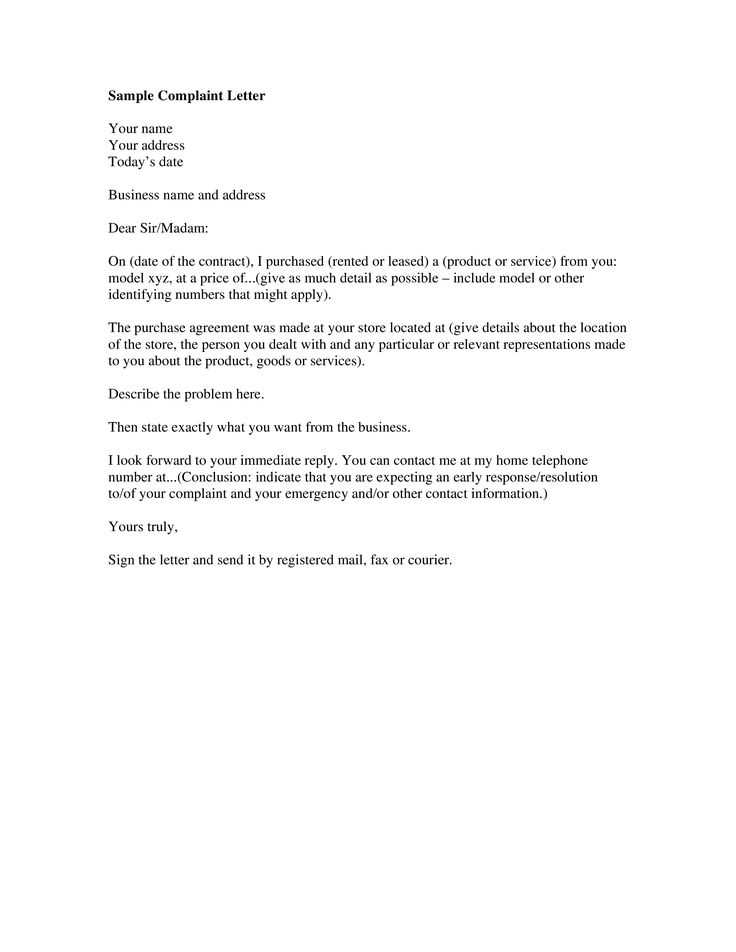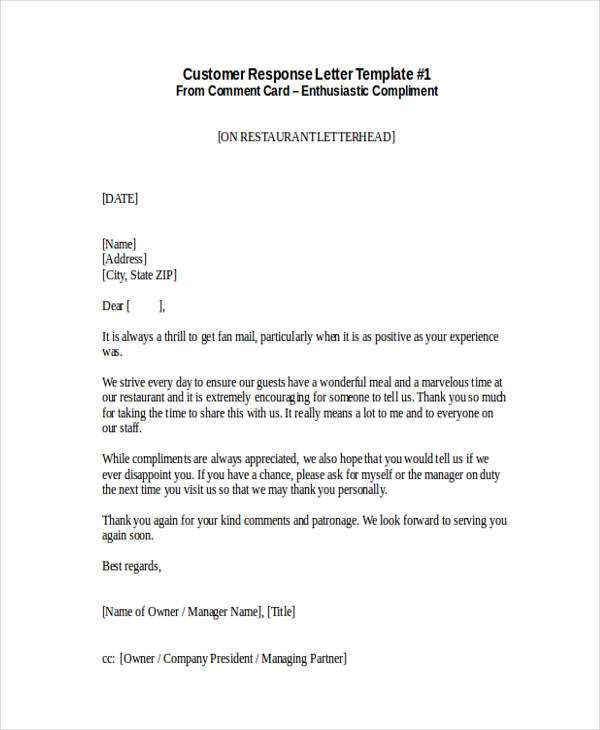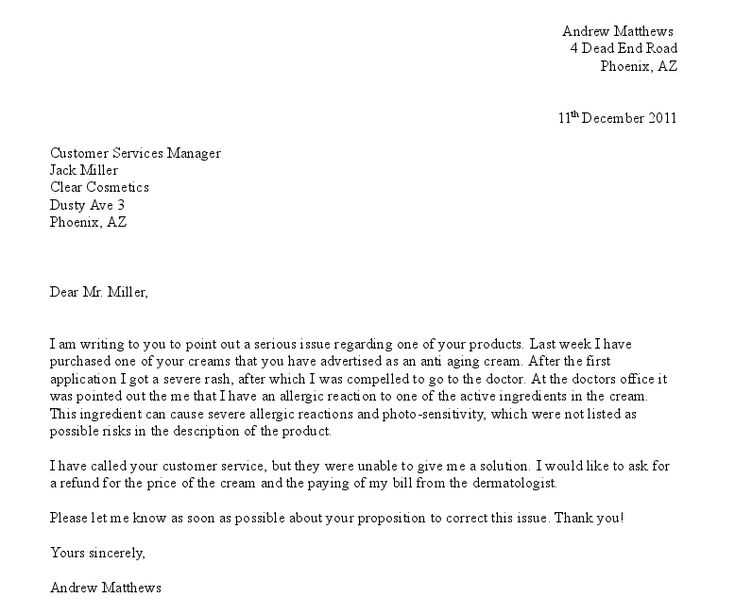Effective Template for Responding to Complaint Letters

Addressing negative feedback in a professional and timely manner is essential for maintaining strong relationships with clients. A well-constructed reply can turn a dissatisfied customer into a loyal one. It’s important to respond in a way that shows empathy and professionalism, ensuring the customer feels heard and valued.
By crafting thoughtful and structured replies, businesses can demonstrate their commitment to improving customer experiences. A standard structure helps streamline the process while ensuring consistency in communication. The goal is to create a sense of trust and reliability in the eyes of the customer.
Effective communication in such situations not only resolves the issue but also fosters long-term loyalty. It’s important to remember that how you engage with a customer during challenging moments speaks volumes about your brand’s values and dedication to service excellence.
Why Use a Complaint Letter Response Template
Responding to customer dissatisfaction in a consistent and efficient way is crucial for maintaining trust and satisfaction. By having a predefined structure for handling such situations, businesses can save time while ensuring that every issue is addressed properly. This approach helps avoid overlooking important details and guarantees professionalism in every interaction.
Utilizing a pre-designed framework offers several advantages:
- Consistency: Ensures that every customer gets a response that aligns with the company’s values and tone.
- Efficiency: Speeds up the process of addressing concerns, allowing staff to focus on other tasks.
- Quality control: Helps maintain a high standard in every reply, avoiding mistakes or miscommunication.
- Empathy: Provides a structure that includes appropriate language to express understanding and care.
- Customer satisfaction: Increases the likelihood of resolving issues effectively and improving the overall experience.
Having a structured method in place can lead to better outcomes in customer relations and streamline the workflow. With a clear approach, businesses are more likely to handle customer concerns quickly, leading to positive impressions and fostering loyalty.
Key Elements in a Complaint Response Letter

When addressing a customer’s concern, it is essential to include certain key components in your reply to ensure the message is both professional and effective. These elements not only help convey your understanding but also demonstrate your willingness to resolve the issue and maintain a positive relationship with the client.
The primary factors to consider are:
- Personalized greeting: Acknowledge the customer by name to establish a more personal connection.
- Empathy and understanding: Show genuine concern for the issue raised, reflecting that you value their feedback.
- Clear explanation: Offer a concise and direct account of what happened or what went wrong to clarify any confusion.
- Action plan: Outline the steps you will take or have already taken to address the problem effectively.
- Appreciation: Thank the customer for their feedback, as it helps improve services or products.
- Reassurance: Reinforce your commitment to customer satisfaction and how their experience will be improved moving forward.
Including these components in your message ensures clarity and professionalism, fostering trust and enhancing the overall customer experience. A well-constructed reply can not only resolve the issue at hand but also leave a positive lasting impression.
How to Address Customer Concerns Professionally
Responding to customer issues in a professional manner is key to maintaining a strong and positive relationship. A thoughtful, respectful, and clear approach not only resolves the immediate concern but also fosters long-term trust and loyalty. Being transparent, empathetic, and solution-focused is crucial when addressing these types of matters.
Steps to Handle Issues Effectively
Each interaction with a dissatisfied customer should follow a structured approach to ensure the matter is handled with the utmost care. Below are the critical steps to take when addressing concerns:
| Step | Description |
|---|---|
| 1. Acknowledge the Concern | Start by recognizing the customer’s feelings and the problem. Let them know you understand their frustration. |
| 2. Apologize Sincerely | Offer a genuine apology for any inconvenience caused, even if the issue wasn’t directly your fault. |
| 3. Provide an Explanation | Clearly explain what went wrong, ensuring you do so in a way that is easily understood. |
| 4. Offer a Solution | Propose a resolution that addresses the issue and meets the customer’s expectations. |
| 5. Follow Up | Ensure the customer is satisfied with the solution and offer further assistance if necessary. |
Maintain a Positive Tone
It’s important to keep a calm and positive tone throughout the interaction. Even if the customer is upset, maintaining professionalism and politeness will encourage a more productive conversation. Avoid being defensive or dismissive, and focus on working together to find a solution.
By following these guidelines, businesses can effectively handle customer concerns, ensuring a better experience for both the client and the company.
Step-by-Step Guide to Writing Responses
Addressing customer issues requires a clear, structured approach to ensure both clarity and professionalism. Crafting a reply that resolves the problem effectively while maintaining positive relations is crucial. Below is a detailed guide to writing a well-thought-out message that meets these goals.
Follow these steps to create a comprehensive reply:
- Start with a personalized greeting: Use the customer’s name to make the communication more personal and respectful.
- Acknowledge the issue: Show the customer that you understand their concern and validate their feelings.
- Apologize appropriately: Offer a sincere apology for the inconvenience caused, even if it was not directly your fault.
- Explain the situation: Provide a brief but clear explanation of why the problem occurred, without being defensive or blaming the customer.
- Propose a solution: Offer a clear and reasonable solution to address the concern. If possible, give the customer options to choose from.
- Offer follow-up: Let the customer know you are available for further assistance and will check in to ensure their satisfaction.
By following this step-by-step guide, you can ensure that every reply is thoughtful, professional, and geared toward resolving the issue effectively while maintaining customer satisfaction.
Common Mistakes to Avoid in Replies

When addressing customer concerns, it’s important to communicate carefully and professionally. Even minor mistakes in your message can have a significant impact on the customer’s perception of your business. Avoiding common pitfalls will help ensure that your reply is effective and leaves a positive impression.
Here are some common mistakes to watch out for:
- Being defensive: Responding in a defensive manner can escalate the situation. Instead, focus on understanding the concern and offering solutions.
- Using generic language: Generic or impersonal responses can make customers feel undervalued. Personalize your message to show that you genuinely care about their issue.
- Over-promising: Avoid making promises you cannot keep. Be realistic about what you can do to resolve the issue and set clear expectations.
- Ignoring the customer’s emotions: Failing to acknowledge how the customer feels can come across as dismissive. Show empathy to create a connection and reassure them.
- Being vague: Offering unclear or non-specific solutions can leave the customer frustrated. Provide concrete actions or steps that address their concern directly.
- Delaying the reply: Taking too long to reply can worsen the issue. Respond in a timely manner to show that you value the customer’s time and concerns.
By avoiding these mistakes, you can ensure your reply is professional, empathetic, and focused on resolving the issue at hand, leaving the customer with a more positive experience.
Improving Customer Satisfaction with Templates
When addressing customer issues, providing consistent, thoughtful, and timely replies can significantly enhance overall satisfaction. One way to achieve this is by having structured frameworks for communication that ensure clarity, professionalism, and empathy. These frameworks help businesses address concerns swiftly while maintaining a high standard of service.
Consistency in Communication

Having a predefined structure allows businesses to deliver consistent messages that align with the brand’s voice and values. This consistency reassures customers that they will receive a reliable and organized response every time they reach out with a concern. It eliminates confusion and builds trust over time.
Time Efficiency and Accuracy
Using well-organized formats enables businesses to respond more quickly, reducing wait times for customers. A fast response, combined with accurate information, helps customers feel valued and heard. This efficient approach allows businesses to resolve issues promptly, preventing them from escalating further.
By incorporating structured communication into your customer service process, you can enhance satisfaction, foster loyalty, and create a positive experience that customers will remember. It streamlines operations while ensuring that every concern is addressed with care and professionalism.